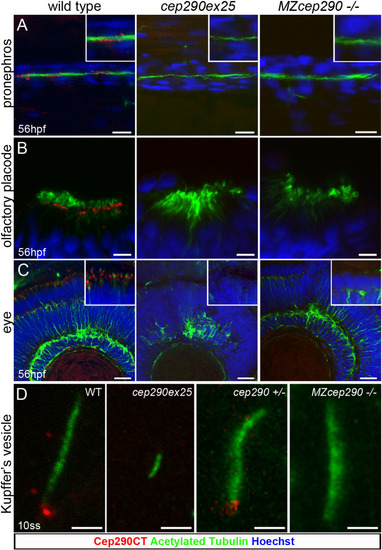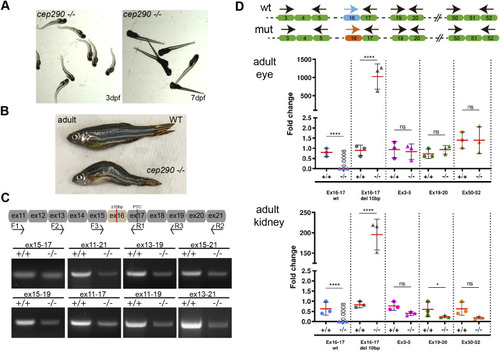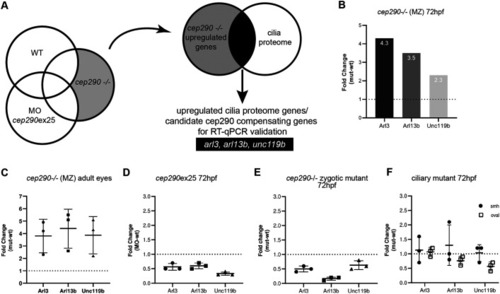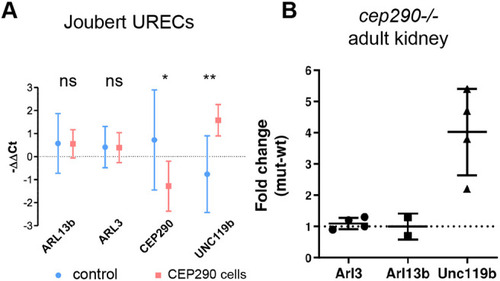- Title
-
Genetic compensation for cilia defects in cep290/NPHP6 mutants by upregulation of cilia-associated small GTPases
- Authors
- Cardenas-Rodriguez, M., Austin-Tse, C., Bergboer, J.G.M., Molinari, E., Sugano, Y., Bachmann-Gagescu, R., Sayer, J.A., Drummond, I.A.
- Source
- Full text @ J. Cell Sci.
|
Cep290 disruption causes ciliopathy in zebrafish. (A) RT-PCR from representative single wild-type (WT) and cep290ex25 morphant embryos. Cep290 morpholino oligonucleotide targeted to the exon 25 splice donor caused mispliced RNAs and intron retention. (B) Chromatogram of a CRISPR/Cas9-generated single representative genetic cep290 mutant showing the 10-bp deletion in exon 16 that results in a premature stop codon. (C) Morphology of an uninjected embryo compared to cep290ex25 and cep290ATG morphants at 2 dpf. (D) Morphology of wild-type and MZcep290fb208/fb208 mutants (hereafter called MZcep290−/− mutants) at 3 dpf. (E) Western blot showing loss of Cep290CT immunoreactivity in cep290ATG and cep290ex25 morphants (pool of 40 48-hpf embryos). The position of the 250-kDa molecular weight marker is indicated in red. A tubulin antibody was used as a loading control (bottom). (F) Western blot showing loss of Cep290CT and Cep290NT immunoreactivity in MZcep290−/− mutants. A tubulin antibody was used as a loading control. Experiments were replicated a minimum of three times. EXPRESSION / LABELING:
PHENOTYPE:
|
|
EXPRESSION / LABELING:
PHENOTYPE:
|
|
PHENOTYPE:
|
|
PHENOTYPE:
|
|
arl3, arl13b and unc119b are upregulated in MZcep290 mutants. (A) RNAseq workflow for the identification of candidate cep290 compensating genes. RNAseq gene expression analysis was performed with 3-dpf cep290ex25 morphants, cep290 mutants and sibling wild-type (WT) embryos (NCBI GEO accession GSE175491), with three biological replicates. Upregulated genes in each group were identified, and genes specifically upregulated in MZcep290−/− mutants were selected for further analysis. MZcep290 upregulated genes were compared to a cilia proteome database to identify candidate cep290 compensating cilia-related genes. (B) RNAseq results showing upregulation of cilia-related genes arl3, arl13b and unc119b in 72-hpf embryos. (C) RT-qPCR quantification of arl3, arl13b and unc119b from MZcep290 mutant adult eye samples. n=3 biological replicates per condition; technical triplicates. (D) The upregulation of arl3, arl13b and unc119b was not detected at 3 dpf in cep290ex25 morphants embryos. n=20 embryos pooled per condition; technical triplicates. (E) The upregulation of arl3, arl13b and unc119b also was not detected at 3 dpf in cep290 zygotic mutants embryos. n=20 embryos pooled per condition; technical triplicates. (F) The ciliary mutants smh (ccdc103) and oval (ift88) did not show upregulation of arl3, arl13b and unc119b at 3 dpf. n=20 embryos pooled per condition; technical triplicates. All RT-qPCR data are expressed as fold change (2−ΔΔCt) compared with age-matched control embryos. Data are mean±s.d. EXPRESSION / LABELING:
PHENOTYPE:
|
|
Joubert patient-derived cells also show upregulation of UNC119b. (A) RT-qPCR analysis from hURECs from JBTS CEP290 patients showed upregulation of UNC119B expression compared with control patient samples. No change in ARL3 and ARL13B gene expression level was observed. Values (dots) represent arithmetic means of −ΔΔCt values between experimental replicates (three controls, four CEP290 patients). Bars represent 95% c.i. *P<0.05; **P<0.01; ns, not significant (unpaired t-test, two-tailed). (B) In zebrafish MZcep290−/− adult kidney samples also only unc119b induction was observed. n=3 biological replicates per condition, technical triplicates. RT-qPCR data are expressed as fold change (2−ΔΔCt) compared with age-matched control samples. Data are mean±s.d. |
|
PHENOTYPE:
|

ZFIN is incorporating published figure images and captions as part of an ongoing project. Figures from some publications have not yet been curated, or are not available for display because of copyright restrictions. |

ZFIN is incorporating published figure images and captions as part of an ongoing project. Figures from some publications have not yet been curated, or are not available for display because of copyright restrictions. EXPRESSION / LABELING:
|







